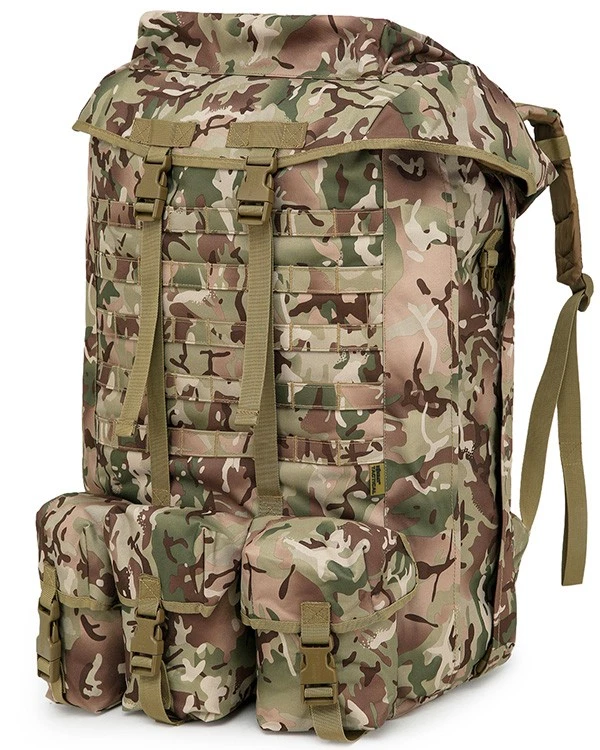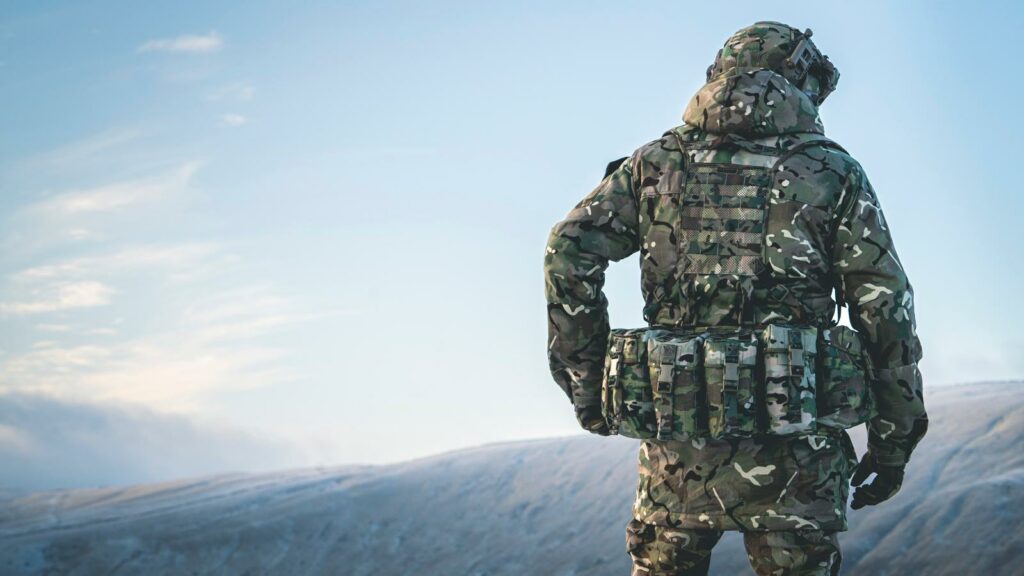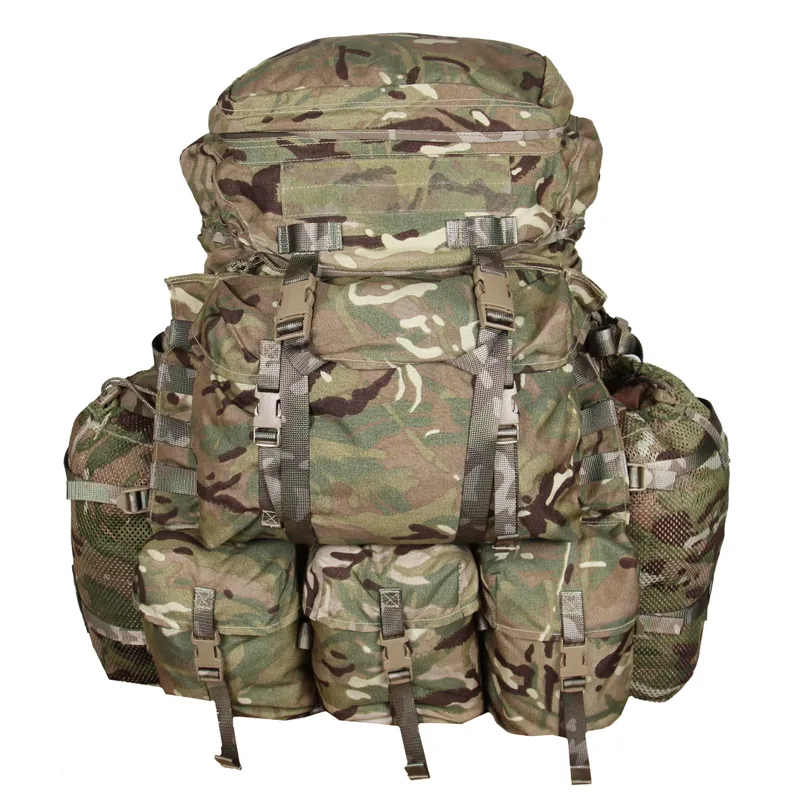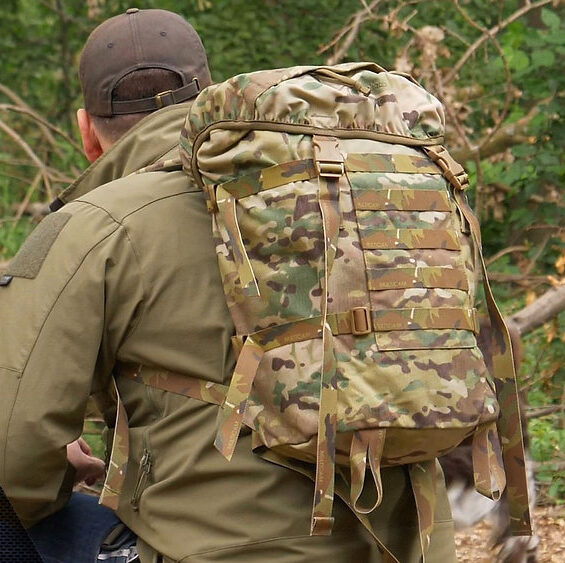Gear Discussion: Rucks, Assault Packs, Webbing: Some Points
This all started from a post in the MVT Alumni Signal Chat, with the posting of this image and the asking of advice on what ruck to buy:

This got me going with a whole bunch of information that I needed to download, and I’ll try to replicate some of that here. The ruck above is advertised as an MTP Para / SAS built ruck that replicates the ‘short back’ issued ruck that we used to have. A ruck in the British Military (BritMil) is known as a bergan, after the Norwegian town that started the whole thing related to cross country skiing! The question was not only related to rucks / bergans, but tied to the use by this group of a full set of webbing. I had previously given advice on this, and steered students towards the short back PLCE bergan, because what we used to do was have the bergan sit on top of the webbing, which would act as a waist belt, and take some of the weight off our shoulders. This individual / group has taken the full set of webbing concept to heart and has adopted that as the way to go.
Before I go on, I have previously posted about gear and the need to be as light as possible while still carrying what is required to operate in the same way as a ‘light infantry soldier.’ I do not wear a full set of webbing, but a hybrid which is not designed to carry a full load of rations and water, and I pair that with either a plate carrier and small attached daypack, or a larger daypack if I am not wearing the plate carrier. Mission dependent. I made several posts about this. My gear has moved on since I made the posts, and I’m currently wearing AttakPak gear, on which I can do a post later. There are a couple of links to relevant posts below. If you go to the blog and put ‘gear’ in the search panel, many posts will come up.
Gear: The MVT Lite Fight Concept
GEAR: The Combat Load + Practical Use of Ballistic Plates.
What do I mean by a ‘full set of webbing’? Something like this:

This is a traditional set of gear worn by the Britmil. It can be worn with or without a slick plate carrier. The idea behind this gear is that not only does it carry your first line ammunition scales, but the pouches on the back allow for the carriage of water, rations and a stove. The idea being that you can cook and administer yourself out of this gear. I did a YouTube video about a set of JayJays webbing:
My first reaction to the posting of the ruck at the top of this post was to say Noooooooo! This was because of all the advice I had been giving out about the need to reduce weight. If you are moving in webbing and rucks, and you get contacted, you will dump the ruck and never see it again. But I do understand why there may be a need to carry one, but I would say that would be for specific types of operations, such as dismounted patrol base operations. If you are operating from a hard base, probably not. I did feel the need at this point to pass on what it was that we actually did, when I was serving in airborne forces. So I will do my best to recollect those points here:
Firstly, the three pouches that are on the back of the ruck. We used to sew those pouches on. The idea being (stolen from the three pouches on the back of the large ALICE ruck) was to use them to administrate yourself in the patrol base. You could keep a canteen, metal mug (to cook in), rations, and your purchased propane stove in those pouches (the solid fuel Hexamine (Hexy) stove was issued). In a similar way to how I showed you in the above video how to admin yourself out of your webbing, you could sit next to your ruck, in your shell scrape in your patrol base, and do the same. This was convenient because you firstly didn’t have to go inside the ruck, and you didn’t have to mess with the contents of your webbing. I will come on to webbing and daysack shortly, but you were supposed to be able to survive with your webbing / daysack for minimum 48 hours in the field without resupply, and it was easiest not to mess with how your rations were packed into your webbing, so just use the pouches on the ruck. When it came time to restock the outside pouches, you could do it from inside the ruck where further rations were carried.


Above (left) we have an original PLCE (personnel load carrying equipment) ruck, with the standard ETH (entrenching tool holder) pouch on the back. On the right we have a modified one with the three pouches. Both rucks have zip-on side pouches attached. The army standard solution for an assault pack, it to detach the two side pouches, zip them together, and wear then as an assault pack. You will be derided for wearing a ‘rocket pack’ if you ever do that!
Enter the assault pack (daypack). What we would do is purchase the Berghaus Munro original daypack. It was olive green and probably about 30 liters in size. That has been replaced in more modern times with the Munro 2, which is 35 liters. I am having trouble pulling up images of the Munro, probably because it comes from a time so long ago before they had cameras, but here are a couple of images of the Munro 2:


This is what we would do. We would pack our bergan and have the sleeping bag easily accessible in the top of the bergan. It would be kept inside the Gore-Tex bivvy bag and we would not use a stuff sack, so the sleep system is just stuffed away into the ruck. It wasn’t at the top of the ruck, because the contents of the inside of the ruck would end up pushed down because we would carry our assault pack sideways and stored under the lid of the bergan. It wasn’t inside the bergan, but it was under the top lid and the contents of the bergan were pushed down. The reason we did this was to ensure that we had our assault pack ready to go and easily grabbed. If we were doing some operation, and we carried our rucks forward into the FRV (ORP), we would cache the rucks and grab the assault packs. Alternately, we might be operating from a static patrol base, with the rucks being back at the base and we would be moving in webbing and assault packs.
The reason for the sleep system was because anytime you were not inside it asleep, it needed to be packed away. So anytime you got up, whether that was for stand-to, going on sentry duty, or any other reason. You did not leave your sleeping stuff just laid out in your shell scrape. This meant that you were always ready to go, and if someone else had to grab your ruck, it was already packed. The same goes for using pouches. If you were admining yourself such as making some food and a brew, you would remove items from a pouch and always do up the pouch. So you would put away your sleeping mat, and sleep system. The use of a tarp (basha) was more complicated. I would keep mine in the top pouch of my ruck. Theoretically they would have to come down for stand-to. It might be, if it was pouring rain, they would just need to be set up low over the shell scrape and they could be left up. Stand-to is approximately 30 minutes over dawn and dusk when traditionally you are most likely to be attacked and you are going through the transition from day to night operations. So everyone is down and ready to go, all gear packed away, equipment on, as it either grows light or gets dark. Also, you didn’t always have a shell scrape, and if you did you didn’t always have to live in it. Sometimes, around the patrol base track plan, you might put your basha up inside the track with the shell scrapes outside, the idea being you could rush into the scrape in case of attack.
A lot of the reasoning behind this comes from BritMil training with a lot of training happening in the UK where it is mostly cold and rainy. That means you are susceptible for hypothermia unless you get it right. The ‘hot brew’ (coffee, tea, hot chocolate) is essential, as well as getting a hot meal in. You also need the right cold weather gear. In the assault pack we used to carry snugpack type faux-down jackets that could be used when static. They were also something that you could sleep in if you were not near your ruck, which was often the case. ‘Travel light, freeze at night.’ Many a night curled up on my webbing freezing cold, waiting to do something, in the rally point or FRV, or whatever. This idea of the hot brew and hot food has been the mistake of several US soldiers on exchange, I recall a couple of Rangers going down with hypothermia due to the whole mindset of just drinking water and eating cold rations (MRE). A lot of the time training in the US is super hot and humid, and that must be allowed for and adapted to. The British rations, a 24 hour ration pack, are true boil-in-the-bag rations and you can put an entree into water in a metal mug and heat it up. Then you can use the water for a hot brew. You cannot do that with an MRE, so don’t do it; something to do with what the pouch is made from. BritMil rations are probably similar to hiking rations which I believe are true boil in the bag? That is also why you use a stove, and you don’t use a chemical ration heater like with the MRE.
On a side note, and not to make this post a million words long, but the conversation raised some points to me. What if we were replicating this now, but it’s now collapse time? What about a stove? If you run out of propane or solid fuel, what will you do? I have a solo stove that burns twigs. Something to think about. We also discussed rations, and running out of them, and the suitability of pemmican, etc. Also, you have to bury your stove. Dig a little hole, or the bottom of the shell scrape is fine, and set the hexy stove up in it.
My point for the discussion was to point out what and why we did what we did with the ruck, and to make the point that it’s a lot to carry. It would work if you were walking in to a patrol base and conducting operations from there, or doing something specialist such as running OP patrols. Other than that, I would steer clear of carrying a full ruck. The related point I want to make is the weight carried if you are operating with a full set of webbing and a full assault pack. That in itself is significant and unless you are a fit 20 year old infantryman, I’m not sure it is sustainable. To illustrate that, I pulled up some video from YouTube to make the point. Hence, why I have been putting out the fight lite concept and writing articles on it.
In this first video you can see 3 Para on an exercise. In much of the footage you can see they are wearing a full set of webbing and the assault pack. You can even see the green Munroe I referenced. There are other assault packs in there, including the more modern issue ones that you can see have side pockets. This video appears to be about bringing some new guys up to speed and you can see the exhaustion in parts of the video. These are young and fit paratroopers and you can see how exhausted they are:
In this video about Pathfinder selection, there are a couple of clips from the live ranges of patrol SOP training. They are wearing webbing, body armor and assault packs. It’s exhausting! Also, the interview with the Brigadier is at his command tent in Lashkar Gah (Helmand, Afghanistan). I was just checking to make sure I didn’t walk past in the background! At about 6:40 in the video, there are two guys coming down a hillside with large rucks. Guessing that they are recovering from an OP, which would be the only time they would have needed to carry that load.
This video is from a joint exchange exercise in the States. British Paras (3 Para again) attacking US OPFOR. It’s posted just because it shows all this gear I have been referencing. I’m guessing this is taking place at Fort Bragg (i.e. CSA General Braxton Bragg). They are jumping in with body armor. Interestingly, it’s not the modern sets worn on deployment. I’m not sure when it was filmed, but they are wearing MTP, so it’s likely this body armor is worn for training at the time. Now they have the modern Virtus plate carriers which are also worn all the time.
In this photo you can see soldiers of the Parachute Regiment wearing the Virtus plater carrier along with webbing:

What you see in the above photo is the use of webbing for most of the gear carriage. The plate carrier is kept mostly slick, except for a few pouches. There is background to this. During operations in Helmand, when the Osprey body armor was being used, it had a lot of MOLLE on it for the attachment of items. There was a serious threat from IEDs in Helmand and one of the things that the medics were seeing was secondary injuries where items that were on the front of the plate carrier would strike and injure the soldier as secondary from the blast. The worst offender was the bayonets, which many soldiers would carry (it had no sheath) slid down between the MOLLE straps on the front of the plate carrier. As a result of this, there was an order that nothing was to be carried on the Osprey plate carrier. Items were to be kept in the webbing where the pouches had lids to contain items. Even in the photo above, the pouches all have lids on them.
In the 3 Para video from the States above, you see the guys parachuting. This leads me to my next point. If you were doing a full container jump, which was not overhead assault but similar to what you see the guys doing in the video, you would need a container. That container would be dropped on the end of 15 foot of rope once you were under canopy. The container was based around your ruck. The RAF would issue you a large piece of cloth which you would wrap around your container and all the external items, then strap the ruck into a harness to attach it to your parachute gear. That was a total pain in the butt. What we would do is purchase a waterproof bergan cover. It was elasticated and would fit over the ruck. You would attach your webbing around the ruck, above where the 3 pouches were, with the assault pack under the lid, then cover up all your sins with the elasticated cover. Then wrap it with the RAF container harness. Your rifle would go into a cloth case on the side of the container where the suspension strap would be attached, so once you let the container go, your rifle would be on the top side. That’s a totally different deal from jumping overhead assault, wearing your webbing and with your rifle down by your side, but that’s another story. But it does explain where a lot of what we did came from, and that we would have bergan covers over our rucks.
So what this leads us to is the decision that you have to make about what you will carry and how you will do so. Do you need to carry a full ruck? Do you need to carry a full set of webbing? Can you get away with less? Are you going to wear plates, or not? It’s always a total pain carrying a daypack over plates, and if you don’t you will be able to carry a larger daypack, that might have some room in it for some of the items that might have been in the rear pouches of the webbing. Are you wearing any sort of chest rig, which is not something I have discussed in this post? Because a lot of it comes down to having the right space for magazine carriage.
Some admin stuff you ought to consider, above and beyond your fighting gear i.e. weapons and magazines. You need to make decisions about weight and what you can or can’t carry with you. Factors to consider are the type of mission and how long are you going to be out for?
- Weapon cleaning kit / oil: enough gear to battle clean your weapon and prevent it rusting up out in the elements.
- Cleaning rod, the type you can screw together. For stuck cases.
- Spare parts / bolt for your rifle.
- Night vision.
- Thermal.
- Flashlight.
- Water: canteen or camelback.
- Water purification system or tablets and way to easily refill camelback.
- Spare batteries of various types.
- Spare socks and foot powder.
- Anti-monkey butt powder.
- Blister kit.
- Boo-Boo first aid kit (separate from IFAK).
- Any medications you need.
- Pain meds / cough drops / hard candy.
- Warm gear as necessary – seasonal dependent.
- Extra water as necessary- seasonal dependent.
- Rations or snacks? Pemmican?
- Stove or not to stove.
- Morale snack – chocolate or something.
- Sewing kit.
- Metal mug / canteen combination or mess kit?
- Fork (also known as racing spoon).
Which reminds me: if you are sleeping out there on operations, your boots stay on in the sleeping bag. Just loosen the laces. Depending on the environment this can take a few variations. If you are sleeping in the jungle you will run a wet kit / dry kit routine where you change out of your gear wet from the day into another uniform to sleep in. But you need something on your feet. Anything that you put on your feet you need to be able to fight in it if woken to a contact, including having to pack up and bug out under enemy fire. If you are going to sleep in your boots, then you would need to powder your feet and change socks, otherwise you will have nasty feet and if wet you may suffer from trench foot. All of this is part of what we would call ‘admin in the field’ the only thing I can think of that is no longer applicable is shaving (did you know the British Army has now authorized beards?) But you still have to clean your teeth!
The carriage of equipment is always a thorny topic and the danger is that you take too much and lose tactical mobility, which can lead you to be exhausted and make poor tactical decisions. I am more of the mindset now that if you are not sure you will need it, don’t take it. You’ll soon find out! I think that applies for most items unless they have a strict safety function.
Comment below in case you need more clarification or want to ask questions.
Novels and Manuals Available!
Must Read Tactical and Dystopian Thrillers!
Genuine & Modern military tactics

Books in the series:
Book 1: Patriot Dawn: The Resistance Rises.
Book 2: Patriot Rising: The Unbroken.
Book 3: The Storm Rages: Dragon Rising.



Leave a Reply
You must be logged in to post a comment.